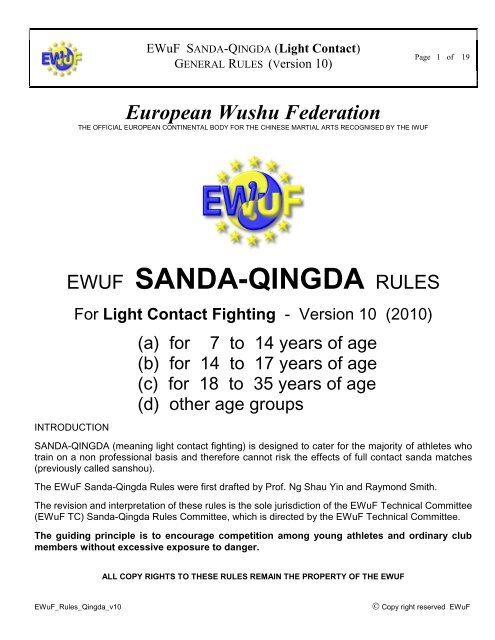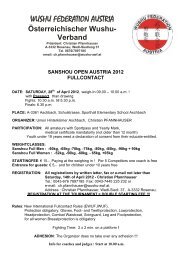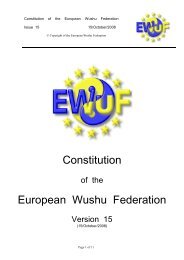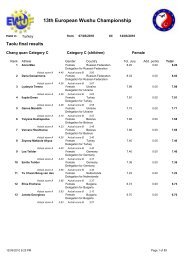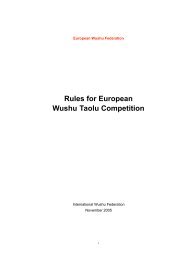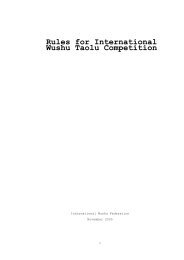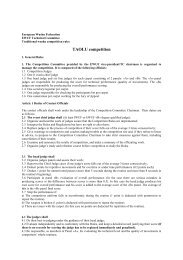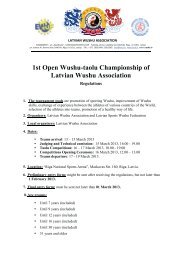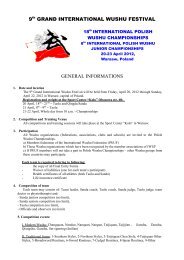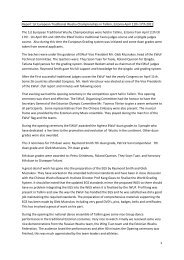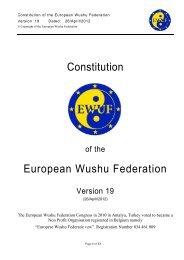Qingda Rules v10 - European Wushu Federation
Qingda Rules v10 - European Wushu Federation
Qingda Rules v10 - European Wushu Federation
Create successful ePaper yourself
Turn your PDF publications into a flip-book with our unique Google optimized e-Paper software.
EWuF SANDA-QINGDA (Light Contact)GENERAL RULES (Version 10)Page 1 of 19<strong>European</strong> <strong>Wushu</strong> <strong>Federation</strong>THE OFFICIAL EUROPEAN CONTINENTAL BODY FOR THE CHINESE MARTIAL ARTS RECOGNISED BY THE IWUFEWUF SANDA-QINGDA RULESINTRODUCTIONFor Light Contact Fighting - Version 10 (2010)(a) for 7 to 14 years of age(b) for 14 to 17 years of age(c) for 18 to 35 years of age(d) other age groupsSANDA-QINGDA (meaning light contact fighting) is designed to cater for the majority of athletes whotrain on a non professional basis and therefore cannot risk the effects of full contact sanda matches(previously called sanshou).The EWuF Sanda-<strong>Qingda</strong> <strong>Rules</strong> were first drafted by Prof. Ng Shau Yin and Raymond Smith.The revision and interpretation of these rules is the sole jurisdiction of the EWuF Technical Committee(EWuF TC) Sanda-<strong>Qingda</strong> <strong>Rules</strong> Committee, which is directed by the EWuF Technical Committee.The guiding principle is to encourage competition among young athletes and ordinary clubmembers without excessive exposure to danger.ALL COPY RIGHTS TO THESE RULES REMAIN THE PROPERTY OF THE EWUFEWuF_<strong>Rules</strong>_<strong>Qingda</strong>_<strong>v10</strong> Copy right reserved EWuF
EWuF SANDA-QINGDA (Light Contact)GENERAL RULES (Version 10)Page 2 of 19INDEXPreface - Introduction page 1Index - Index of Content page 2Rule 1 - Scope of Participation page 3Rule 2 - Method of Competition page 3Rule 3 - Duration of Contest page 3Rule 4 - Fighting Area page 4Rule 5 - Weight Categories page 4Rule 6 - Medical Procedures page 4Rule 7 - The Pairing of Competitors. page 4Rule 8 - System of Contest page 5Rule 9 - Entrance to Contest Area page 5Rule 10 - Salute page 5Rule 11 - Equipment page 5Rule 12 - Dress Code page 6Rule 13 - Signals During Contest page 7Rule 14 - Method of Attack page 7Rule 15 - Valid Target Areas page 7Rule 16 - Methods of Defence page 7Rule 17 - Suspension of a Fight page 7Rule 18 - Prohibited Techniques page 8Rule 19 - Prohibited Areas of Attack page 8Rule 20 - Fouls, Warnings and Penalties page 9Rule 21 - Absolute Victory page 10Rule 22 - Scoring Criteria page 10Rule 23 - Disqualification page 11Rule 24 - Decisions page 11Rule 25 - Appeals page 11Rule 26 - Anti Doping page 12Rule 27- Other Matters page 12Rule 28 - By-Laws page 12Appendix A Referees Calls and Signals page 13-19EWuF_<strong>Rules</strong>_<strong>Qingda</strong>_<strong>v10</strong> Copy right reserved EWuF
EWuF SANDA-QINGDA (Light Contact)GENERAL RULES (Version 10)Page 3 of 19Rule 1 - Scope of ParticipationThis will be defined by the EWuF TC Chairman directly or by the EWuF Sanda-<strong>Qingda</strong> <strong>Rules</strong> Committee in conjunction withthe competition organisers at the time of advertising an event. It is aimed at „juniors‟ between 7 and 14 years old and „youths‟15 to 17 years old and adults 18 to 35 years old groups. Further consideration may be given later to a veteran‟s event subjectto the EWuF Medical Commission. Cadet categories can also be used.The Sanda-<strong>Qingda</strong> event is intended for LIGHT CONTACT fighting only. Therefore Sanda fighters (fully contact fighters) whohave taken part in EWuF or IWUF Sanda events are not eligible to take part in Sanda-<strong>Qingda</strong>. Once a competitor changesfrom Sanda-<strong>Qingda</strong> to Sanda they may not take part in Sanda-<strong>Qingda</strong> again unless they apply to the EWuF TC forreclassification. In any event should such reclassification if given can only be given once and this is without exception.Rule 2 - Method of Competition2.1 Individuals shall compete in tournaments by category, which shall be defined as:(a) under 14‟s: the minimal age shall be 7 years. Categories defined by organisers, usually two year increments.(b) 14 and 15 years of age(c) 16 and 17 years of age(d) 18 and above: the maximal age shall be 35 years(e) Optional: Cadet category 17 and 18 years of age(f) Optional: Senior category 36 to 45 years of ageAges are defined by the age of the competitor on the 1 st January of the year of the event they are competing in (NOTTHEIR BIRTHDAY).Each age group may, subject to numbers, be further sub-divided by weight and height with the agreement of theorganisers and the Chief Head Judge. This can be achieved at the weighting in session but prior to draw lots.If there are insufficient numbers in any level or group they will be merged with another level or group if such is judgedto be safe with the agreement of the organisers and the Chief Head JudgeIn the under 15‟s and under 18‟s categories if a contestant is deemed by the Chief Head Judge to be too big for theirgroup they can be re-assigned to a higher group. This does not apply in the other direction.2.2 League matches will follow the same scoring method for bouts. Construction of a league, and the match order, shallbe defined by the organiser after consulting with the EWuF TC.2.3 The rules and regulations of the EWuF will be applied.Rule 3 - Duration of ContestThe duration of each match will be set by the organisers and approved by the rules committee but shall not exceed 2 minutesper round. In the case of a single bout to decide the category the best of three rounds may be used, the third round only beingplayed if the score is one round each at the end of the second round. The time between rounds shall be one minute but canbe reduced to half the length of a round. If a large number of bouts are to be undertaken the organisers can reduce the flightsto one round.EWuF_<strong>Rules</strong>_<strong>Qingda</strong>_<strong>v10</strong> Copy right reserved EWuF
EWuF SANDA-QINGDA (Light Contact)GENERAL RULES (Version 10)Page 4 of 19Rule 4 - Fighting Area4.1 The contest area shall be a maximum of 8 meters square with a 2 meter safety zones around it. This area shall becovered with mats. The size of the area can be reduced if agreed by the Organisers and the Chief Head Judge.Optional a Platform according to the IWUF Sanshou <strong>Rules</strong> can be used.The area will have two parallel lines (the competitors standing lines), each a meter long, shall be drawn at a distanceof 1.5 meters from and on either side of the centre point of the fighting area.A one meter line shall be drawn 2 meters from the centre of the match area at right angles to the contestant‟s lines.This shall be the Referees standing line, such that the Referee will be facing the head Judges table.Rule 5 - Weight Categories(a) Under 18's (b) Over 18'sAllows for under 48 kg under 52 kg (but not less than 48 kg)each category being in under 56 kg 52 kg to 56 kgincrements of 3 kg under 60 kg 56 kg to 60 kgunder 65 kg 60 kg to 65 kgAfter 48 kg the over 18's under 70 kg 65 kg to 70 kgcategories apply under 75 kg 70 kg to 75 kgunder 80 kg 75 kg to 80 kgunder 85 kg 80 kg to 85 kgunder 90 kg 85 kg to 90 kgover 90 kg(c)League Matches: Weight categories will be decided prior to the event and allow for no more than:c.1 Under 14 years (between 7 & 13 years) a max of 5Kg variance between lightest and heaviest competitor.c.2 Over 14 year a maximum of 8 Kg variance between lightest and heaviest team members.Rule 6 - Medical Procedures6.1 All athletes must be available for medical inspection including dope testing as and when required by the EWuF.6.2 <strong>Qingda</strong> competitors can only enter the correct age and weight categories (rule 2 may apply).6.3 Documents (EWuF membership card) must be produced during weighing in and be checked for any medical entry byan authorised person before the contestant can proceed into the event.6.4 Suitably qualified and experienced first aides must be present during the conduct of a bout.6.5 For international events a passport check on nationality will also take place.6.6 Compliance with medical certification of health which from time to time is required by the Medical Commission andspecified in the event regulations.Rule 7 - The Pairing of Competitors.In conjunction with, <strong>Rules</strong> 2 and 5 above. Lots will be drawn, to pair off competitors before the event in accordance with anyadjustments made to the categories by the organisers. If seeding of participants is used only none seeded participants willhave lots drawn. The drawing of lots will be carried out in the presence of a EWuF recognised official appointed in conjunctionwith the competition organisers.EWuF_<strong>Rules</strong>_<strong>Qingda</strong>_<strong>v10</strong> Copy right reserved EWuF
EWuF SANDA-QINGDA (Light Contact)GENERAL RULES (Version 10)Page 6 of 19Rule 12 - Dress Code12.a)AthletesFailure to comply with this rule will mean disqualification of the contestant from the competition.12.1 The competitors must provide their own clothing, which must be clean and well presented. It shall consist of either atraining jacket or plain tee shirt and long trousers (no shorts or boxing trunks will be allowed). Tops must not becovered in prints or be multi coloured. Badges of the competitors association, national federation and that of theEWuF are permitted. No advertising shall be permitted unless specified by the EWuF Executive Committee. TheChief Head Judge will have the final say as to whether any clothing is or is not acceptable in competitions.12.2 Spectacles, hard contact lenses and dentures must not be worn.12.3 All jewellery, including such items as; rings, earrings, studs, pendants and necklaces must be removed. Rings, whichcannot be removed must be taped over. If the ring is still considered dangerous the contestant will not be allowed totake part. The Chief Head Judge will have the final say as to whether any such item is or is not acceptable incompetitions.12.4 Any cuts or lacerations must be covered with a medically approved plaster, which will protect both the contestantand others from contact with blood.12.5 Injured athletes will not be permitted to take part, however if an elasticated support is required one may be usedsubject to the approval of the Chief Head Judge.12.6 The competitors will be bear footed during the matches. However it is strongly recommended that all competitorswear appropriate foot covering when not engaged in match play.12.7 Personal hygiene. Competitors must commence the event in a clean non body odour manner with all hand and footnails cut short and filed smooth.12.b)Judges12.8 Judges will at all times present themselves in a clean and tidy appearance.12.9 Judges shall wear the prescribed attire, which shall be either specifically announced for the event and may includeitems such as specially printed tee/sweat shirts or track suits. Otherwise the standard dress code shall be blackshoes, black socks, grey trousers, black belt, white shirt (short or long sleeves), EWuF tie and a single breasted navyblazer.12.10 Judges who Referee may wear suitable shoes in either white or black and a black bow tie.12.11 Judges who Referee are required to wear rubber gloves to protect them against contact with blood.12.12 Judges who Referee will require a whistle on a ribbon suitable to be worn around the neck.12.13 All Judges shall carry two pens (one as a spare) to record their scores.EWuF_<strong>Rules</strong>_<strong>Qingda</strong>_<strong>v10</strong> Copy right reserved EWuF
EWuF SANDA-QINGDA (Light Contact)GENERAL RULES (Version 10)Page 7 of 19Rule 13 - Signals During Contest13.1 An agreed signal will be given 5 seconds before each round begins and at the end of each round.13.2 The competitors and their seconds will obey the calls and hand signals of the Referee unconditionally.13.3 The Head Judge will stop the fight if there is any problem during the round.13.4 When a contestant receives maximum negative points, the Score Keeper will signal the Referee.13.5 At the end of each round the Head Judge will signal and the Scoring Judges will show their score by awarding a winto one or other of the competitors or show a draw. All Judges must show their scores at the same time.13.6 To assist the Referee the Score Keeper will update signboards at the match table for recording leaving the fight areaand negative points.13.7 Signals given by the Referee are described in appendix ARule 14 - Method of AttackMovements of any wushu style or system, which are not forbidden by the rules, may be used to attack any valid target area onan opponent‟s body. Kicks, strikes, sweeps and throws (only those mentioned in rule 22) are allowed, subject to the specificrestrictions placed on these techniques by the rules and applied with variation according to the age of participants.Rule 15 - Valid Target Areas15.1 The sides of the head.15.2 The trunk.15.3 The sides and backs of the legs.Rule 16 - Methods of DefenceMovements of any wushu style or system, unless specifically forbidden in the rules, may be used to defend against attacks.Rule 17 - Suspension of a FightThe Referee will suspend the fight when:-17.1 A contestant has fallen down or out of the area.17.2 A contestant is penalised for a foul.17.3 A contestant is injured.17.4 There is continuous contact between the competitors for more than 3 seconds.17.5 There is passivity.17.6 The Head Judge finds reason to stop the bout.17.7 There is any danger during the bout.EWuF_<strong>Rules</strong>_<strong>Qingda</strong>_<strong>v10</strong> Copy right reserved EWuF
EWuF SANDA-QINGDA (Light Contact)GENERAL RULES (Version 10)Page 8 of 19Rule 18 - Prohibited Techniques18.1. The following techniques are strictly prohibited:-18.1.1 Striking to or at the face whether making contact or as a feint.18.1.2 Direct attacks to limbs (see rule 15) and joints.18.1.3 Head butt, elbow and knee strikes18.1.4 Dangerous throws - Any throw that is likely to cause serious injury (eg: neck, stomach and shoulder highthrows). Throws which cause a contestant to land awkwardly on a vulnerable part of the anatomy (head,neck, spine, shoulder, knee or other joint etc...). Throws with a falling height from above the attackers chestlevel.18.1.5 Time wasting18.1.6 Finger thrusts to any part of the body.18.1.7 Choke or strangle techniques.18.1.8 Grappling or clinching for more than 3 seconds.18.1.9 Grappling or wrestling on the mat.18.1.10 Arm locks and similar joint-locking techniques.18.1.11 Grasping an opponent with one or two hands and striking with the other hand or kicking.18.1.12 Biting, scratching, hair pulling, spitting etc...18.1.13 Continuous hitting to any part of the body especially the head.18.1 14 Pushing the opponent for more than 1 meter18.2. All techniques which are deliberately intended to injure the opponent rather than to score points are prohibited whetheron target or not. The consideration will be judged on what would have happened if the blow had landed.18.3. Force of strikes is deemed reasonable at less than 10% of potential power for any category, more than that will beconsidered excessive and will lead to private or public warnings and/or disqualification (with or without prior warning).The determination as to how much force was used in any attack shall be the responsibility of the Referee and the HeadJudge.Rule 19 - Prohibited Areas of AttackThe following parts of the body are prohibited to any type of attack.19.1 Face19.2 Back of the head.19.3 The eyes and throat.19.4 The groin.19.5 The back (spine).19.6 The kidneys.19.7 The knees, elbows and other joints.EWuF_<strong>Rules</strong>_<strong>Qingda</strong>_<strong>v10</strong> Copy right reserved EWuF
EWuF SANDA-QINGDA (Light Contact)GENERAL RULES (Version 10)Page 9 of 19Rule 20 - Fouls, Warnings and PenaltiesIf a foul or other prohibited act is committed the Referee for the bout or the Head Judge of the contest area may give warningsor penalties. When the sum of penalties awarded reaches or exceeds the maximum permitted for the specific match either 3points for a single round bout or 6 points for a best of 3 round bout an automatic disqualification shall apply to that bout. Whenthe bout is of more than one round the penalties shall roll over from one round to the subsequent rounds in that bout.Penalties collected in one bout are not counted in subsequent bouts, which means each participant starts each bout afreshwith a clean score sheet. However the Chief Head Judge can disqualify any participant from any part or from the whole eventif a competitor is deemed to show repeated fouling to gain advantage even if lease than the 6 penalty points are recorded.20.1 When a contestant has committed a prohibited act (with or without causing serious injury), the Referee will assessthe seriousness of the act and award either:- a] a warning (no penalty points).b] a minor penalty (1 point)c] a full penalty (2 points)d] a disqualification.20.2 Coaches who repeatedly offend the spirit of the competition by ignoring the sideline coaching rule may either beawarded a penalty (1 or 2 points) against their athlete, or dismissed from the competition, in which case they mustleave or their team may be disqualified by the Chief Head Judge. In either case a report will be sent to theSanda-<strong>Qingda</strong> Committee for possible further disciplinary procedures. This may also apply to spectators.20.3 Attacking an opponent before the Referee gives the signal to start.20.4 Attacking an opponent after the Referee gives the signal to stop.20.5 Disobeying the Referees instruction or decision.20.6 Attacking in a vicious or malicious manner.20.7 Continuously holding an opponent.20.8 Escaping from fighting by turning the back to the opponent.20.9 Attacking prohibited areas.20.10 Pretending pain or injury to gain advantage.20.11 Disrespect to opponent or officials.20.12 Spitting the gum shield out or other discarding of equipment, which gains rest time or wastes time.The Referee will warn the contestant when they commit any foul or penalty mentioned above and they will receive either awarning or a one or a two point penalty, which will be added to their opponents score.On receipt of the Head Judges report the EWuF TC may impose penalties against any severe offence that results in thecompetitor or their seconds being disqualified or for behaving badly. Penalties may include fines and/or suspensions.Explanations:20a20b20cAccidental Fouls: Permitted techniques, which unintentionally make contact with prohibited areas of the opponentare considered as Accidental Fouls. Sometimes an Accidental Foul is committed through no fault of eithercontestant, but depending on sudden changes of stance, simultaneous attacks, a block redirecting a technique into aforbidden area of their own body etc... This type of Accidental Foul carries no penalty. In other cases an AccidentalFoul may be caused by carelessness on the part of a contestant, which can be subject to warning or penalty.Deliberate Foul: Use of prohibited techniques or intentional attacks to prohibited parts of the body is considered tobe Deliberate Fouls and is always subject to penalty without warning.Technical Fouls: Violations of the rules not concerned with prohibited techniques or attacks to prohibited targets areconsidered as Technical Fouls.EWuF_<strong>Rules</strong>_<strong>Qingda</strong>_<strong>v10</strong> Copy right reserved EWuF
EWuF SANDA-QINGDA (Light Contact)GENERAL RULES (Version 10)Page 10 of 19Rule 21 - Absolute Victory21.1 When there is great disparity in techniques between two competitors the Referee may seek the approval ofthe Head Judge to proclaim the stronger athlete the winner of the bout.21.2 When a contestant accumulated the maximum allowed number of penalty points in a bout; 3 points for a single roundbout or 6 penalty points in a bout of 3 rounds. In such a case the other side shall automatically be declared the winnerof the bout.21.3 If a contestant is forced out of the area or off the platform 3 times in a round the round shall be awarded to the otherside.Rule 22 - Scoring Criteria22.1 2 POINTS will be awarded when:-a] An opponent is forced out of the fight area either by retreating or being hit.b] Pushing an opponent out of the fight area while remaining standing inside the area.c] A clean safe throw while remaining standing or leg sweeping technique including sweeping whirlwindtechnique where the attackers body may touch the ground. In all circumstances the attacker must remaininside the fight area.d] Executing an effective kick to the valid area of the trunk or the heade] When a „Full Penalty‟ is given against the opponent, 2 points will be added to the other contestant.f] Against an opponent making an attempt to attack but slips or falls down (except when part of the attackingtechnique eg: falling whirlwind kick).22.2 1 POINT will be awarded when:-a] Executing an effective punch to a permissible part of the body.b] Executing a effective kick to the leg (unless the leg is raised off the ground in which case it is considered tobe used as a blocking technique against the attack and no score is given).c] When a „Minor Penalty‟ is given against an opponent, one point will be added to the other contestant.d] When both competitors attempt simultaneous throwing techniques, the contestant who hits the ground firstwill have a point awarded against them.e] If both competitors fail to attack within 8 seconds the Referee will indicate a contestant to attack. If after afurther 8 seconds that contestant has not attacked a point will be awarded to the other contestant.22.3 NO SCORE will be awarded when:-a] For simultaneous scores.b] Striking opponents face.c] Exchanging punches and kicks during clinches.d] Any technique that does not land clearly or cleanly.e] Both competitors fall out of (or leave) the fight area.f ] Executing an effective throw after holding an opponent for more than 3 seconds.g] Holding and hitting an opponent.i ] When an opponent is holding and pressing you down for more than 3 seconds and you execute an effectiveleg sweep.j ] Jumping side kick or falling whirlwind kick where the body lands on the floor as part of the technique.k] Executing an effective attack from outside the area.EWuF_<strong>Rules</strong>_<strong>Qingda</strong>_<strong>v10</strong> Copy right reserved EWuF
EWuF SANDA-QINGDA (Light Contact)GENERAL RULES (Version 10)Page 11 of 19Rule 23 - Disqualification23.1 A disqualification applies automatically if a contestant has accumulated a total of the maximum number of penaltypoints permitted in their bout. This shall be 3 penalty point if the bout is of one round duration or 6 penalty points overthe entire duration of a 3 round bout.23.2 A Referee may with the agreement of the Head Judge disqualify a contestant, without prior warning or penaltieshaving been given, if it is deemed that an offence warrants it. In particular this applies to the attitude of the contestantor their seconds towards their opponent or officials, if they demonstrate intention to hurt their opponent whether thestrike lands or not a disqualification may be awarded to either the bout or the total event.Rule 24 - Decisions24.1 The match Referee shall make such decisions as seen fit to ensure the safe conduct of the bout.24.2 The decision of winner of a bout will be by the majority award of the Judges who are scoring the bout. They will onrequest simultaneously show their award either; BLACK or RED as winner or DRAW. The Score Keeper will recordthese scores and the Head Judge will announce the result of the round and subsequently if more than one round theresult of the bout.24.3 Any time the Referee or Judges have a question regarding the bout they can consult the Head Judge who shall givea ruling.24.4 The decision of the Head Judge shall be final and binding in all respects excluding appeals.Rule 25 - Appeals25.1 Only the registered team leader of a competitor may make an appeal against a decision and such an appeal must beput in writing and submitted to the Head Judge via the appeal table or other such designated point that has beenannounced as being set up for that purpose within 15 minutes of the decision. An appeal costs 100 euro and thismoney will be refunded if the appeal is upheld and forfeit to the EWuF if the appeal goes against the appellant. Anybreech of protocol in making an appeal will forfeit the right to appeal and loss of appeal fee if paid. Any appealaccepts rule 25 as binding.25.2 Appeals will be handled by a "Jury of Appeal" .25.3 The Jury of Appeal shall be appointed and dismissed by the EWuF TC Chairman, which shall consist of either:(a) A board of 3 people announced before the event commences. If the appeal concerns a competitor from one of thenations of the appeal board members they will be replaced by another suitable person appointed by the EWuF TCChairman. This board will not consist of the Head Judge or Referee.(b) The three most senior Judges present at the event that will be determined by the EWuF TC Chairman. This boardwill not consist of the Head Judge or Referee or nationality of either athlete of the bout in question.25.4 If the Jury of Appeal upholds the appeal the result will be amended accordingly.25.5 The decision of the Jury of Appeal will be final and binding on all.EWuF_<strong>Rules</strong>_<strong>Qingda</strong>_<strong>v10</strong> Copy right reserved EWuF
EWuF SANDA-QINGDA (Light Contact)GENERAL RULES (Version 10)Page 12 of 19Rule 26 - Anti Doping26.1 All participants shall be subject to the WADA rules relating to Anti Doping as adopted and implemented by the IWUFand EWuF.Rule 27 - Other Matters27.1 The uniform of the Judges and Referees shall be as prescribed by the EWuF minor variations to the rule may begranted by the Chief Head Judge, ie; permission to remove blazer in hot conditions.27.2 Signals given by the Judges and Referees shall be standard as prescribed by the EWuF.27.3 With prior notice the rules can be amended by the EWuF TC to suit the event for which they will be used.27.4 Unless otherwise agreed by the EWuF Congress or other legal vote the rules for any event must be published at least12 months before the event. However for safety reasons small amendments can be made but must be explained andagreed by the majority present at the coaches technical meeting prior to the commencement of the event, or if theIWUF has amended its rules which have a direct effect these rules. Notice of time rule shall be waived for the 1 st<strong>European</strong> Traditional Championship in 2011. Thereafter it shall be enforced (at which time this sentence shall bedeleted).Rule 28 - By-Laws of the Governing Body shall apply where appropriate.NOTE:For the purposes of the 1 st Traditional Championships the Jury of Appeal shall be appointed by EWUFEC. Thereafter as specified in the <strong>Rules</strong>.E N DAPPENDIX A = Calls and Hand SignalsEWuF_<strong>Rules</strong>_<strong>Qingda</strong>_<strong>v10</strong> Copy right reserved EWuF
EWuF SANDA-QINGDA (Light Contact)GENERAL RULES (Version 10)Page 13 of 19APPENDIX ACALLS AND GESTURESA1 Platform Judge’s Calls and GesturesA1.1 Fist-Palm SaluteIn a standing position with feet together. place the left palm against the right fist in front of and 20-30 cm away from the chest.(Figs 1 and 2).A1.2 Mount the platformFig 1 Fig 2 Fig 3 Fig 4Standing at the centre of the platform, extend both arms sideways, palms up and pointing at the competitors (Fig 3). As a callon them to mount the platform, bend both arms at the elbow into a right angle, palms facing each other (Fig 4).A1.3 Competitors salute each otherPlace the left hand on top of the right fist in front of the body as a signal to both competitors to salute each other (Fig 5).Fig 5 Fig 6 Fig 7 Fig 8Salute each other First round Second round Third roundEWuF_<strong>Rules</strong>_<strong>Qingda</strong>_<strong>v10</strong> Copy right reserved EWuF
EWuF SANDA-QINGDA (Light Contact)GENERAL RULES (Version 10)Page 14 of 19A1.4 First roundFacing the head judge, take a bow stance and, while calling “Diyiju Round one” extend one arm forward with the index fingerpointing up and the other three fingers and the thumb clenched into a fist (Fig 6).A1.5 Second roundFacing the head judge, take a bow stance and, while calling “Di‟erjuor Round 2”, extend one arm forward with the index andmiddle fingers separated and pointing up, and the thumb and the other two fingers clenched (Fig 7).A1.6 Third roundFacing the head judge, take a bow stance and, while calling “Disanju or Round 3”, extend one arm forward with the thumband the index and middle fingers separated and pointing up and the other two fingers clenched (Fig 8).A1.7 Make ReadyTake a bow stance between the two competitors and, while calling “Yubei or Ready!" extend both arms sideways, palm facingup and pointing at the competitors (Fig 9). Then, while calling “Kaishi or Start!” cross open palms in front of the abdomen (Fig10).A1.8 "Ting (Stop)!”Fig 9 Fig 10While calling "Ting (Stop)!” take a bow stance and insert one extended arm between the two competitors, fingers pointing up(Figs 11-12).Fig 11 Fig 12EWuF_<strong>Rules</strong>_<strong>Qingda</strong>_<strong>v10</strong> Copy right reserved EWuF
EWuF SANDA-QINGDA (Light Contact)GENERAL RULES (Version 10)Page 15 of 19A1.9 8-second passivityWhile calling Red side or Black side raise both hands in front of the body, with the small and ring fingers of one hand bent andthe thumbs and other fingers of both hands separated and stretched naturally (Fig 13).Fig 13 Fig 14 Fig 15 Fig 168-second passivity 10 Count PassiveA1.10 CountFacing the fallen competitor, with both arms bent at elbow and both hands clenched into fists in front of the body, palm sidefacing forward, unbend the fingers one by one from the thumb to the little finger, at an interval of one (1) second (Figs 14-15).A1.11 Passive holdFold the arms in front of the body (Fig 16).A1.12 8-second forcible countingFacing the head judge, extend one arm with the thumb pointing up and the other fingers clenched (Fig 17)Fig 17 Fig 18A1.13 Three secondsWhile calling Red side or Black side extend one arm obliquely up with the palm open and pointing at the competitor.Meanwhile, move the other hand across the abdomen to the side of the body, with the thumb and the index and middlefingers separated naturally and the other two fingers clenched (Fig 18).EWuF_<strong>Rules</strong>_<strong>Qingda</strong>_<strong>v10</strong> Copy right reserved EWuF
EWuF SANDA-QINGDA (Light Contact)GENERAL RULES (Version 10)Page 16 of 19A1.14 Appointed attackExtend one arm between the two competitors, with the thumb extended and the fingers clenched, palm side down. Whilecalling Red side or Black side move the hand horizontally in the direction of the thumb as a signal for appointed attack (Fig19).Fig 19 Fig 20 Fig 21 Fig 22Appointed Attack Down Down First Simultaneous DownA1.15 DownWhile calling Red side or Black side extend one arm with palm facing up and pointing at the fallen competitor, as the otherarm moves to the side of the body, bent at elbow and with palm facing down (Fig 20).A1.16 Down FirstExtend one arm towards the competitor who is the first to fall down and, while calling Red side” or Black side cross the armsin front of the abdomen, palms facing down (Figs 21-22).A1.17 Simultaneous DownExtend both arms horizontally forward and withdraw them to press both palms down (Fig 23).Fig 23 Fig 24 Fig 25 Fig 26 Fig 27Simultaneous Down One side off Both sides offEWuF_<strong>Rules</strong>_<strong>Qingda</strong>_<strong>v10</strong> Copy right reserved EWuF
EWuF SANDA-QINGDA (Light Contact)GENERAL RULES (Version 10)Page 17 of 19A1.18 One side off the platformExtend one arm towards the competitor off the platform (Fig 24) and, while calling Red side or Black side push the other handforward in a bow stance, fingers pointing up (Fig 25).A1.19 Both sides off the platformTake a bow step and push both palms forward, arms fully stretched and fingers pointing up (Fig26). Then bend both arms atelbow into a right angle in front of the body, palms facing back, while bringing the feet together to stand upright (Fig 27).A1.20 Kick to crotchExtend one arm towards the offender and, while calling Red side or Black side point the other hand at the crotch, palm facinginward (Fig 28).Fig 28 Fig 29 Fig 30 Fig 31Kick to crotch Hit to back of head Elbow foul Knee foulA1.21 Hit to the back of headExtend one arm towards the offender and, while calling Red side or Black side place the other hand on the back of the head(Fig 29).A1.22 Elbow foulBend both arms in front of the chest and, while calling Red side or Black side cover one elbow with the other hand (Fig 30).A1.23 Knee foulRaise one knee and, while calling Red side or Black side pat the knee with the hand of the same side (Fig 31).EWuF_<strong>Rules</strong>_<strong>Qingda</strong>_<strong>v10</strong> Copy right reserved EWuF
EWuF SANDA-QINGDA (Light Contact)GENERAL RULES (Version 10)Page 18 of 19A1.24 WarningExtend one arm towards the offender, palm up. While calling Red side or Black side bend the other arm at elbow into a rightangle, fingers clenched into a fist with the thumb side facing outward (Fig 32).Fig 32 Fig 33 Fig 34Warning Admonition DisqualificationA1.25 AdmonitionExtend one arm towards the offender, palm up. While calling Red side or Black side indicate the foul with the other hand andbend the arm at elbow into a right angle in front of the body, fingers pointing up and palm facing backward (Fig 33).A1.26 DisqualificationWhile calling Red side or Black side clench both hands into fists and cross the forearms in front of the body (Fig 34).A1.27 Not validExtend both arms and cross them in a swing in front of the abdomen (Figs 35-37).Fig 35 Fig 36 Fig 37EWuF_<strong>Rules</strong>_<strong>Qingda</strong>_<strong>v10</strong> Copy right reserved EWuF
EWuF SANDA-QINGDA (Light Contact)GENERAL RULES (Version 10)Page 19 of 19A1.28 Emergency treatmentFacing the medical supervision desk, cross forearms in front of the chest, fingers pointing up (Fig 38)Fig 38 Fig 39 Fig 40Emergency Treatment Rest Exchange positionsA1.29 RestExtend both arms sideways, palms up, to point at the competitors‟ rest places (Fig 39).A1.30 Exchange positionsStanding at the centre of the platform, cross arms in front of the abdomen (Fig 40)A1.31 DrawStanding between the competitors, hold their wrists and raise their hands. (Fig 41).Fig 41 Fig 42A1.32 WinnerStanding between the competitors, hold the winner„s wrist and raise his hand (Fig 42).EWuF_<strong>Rules</strong>_<strong>Qingda</strong>_<strong>v10</strong> Copy right reserved EWuF


